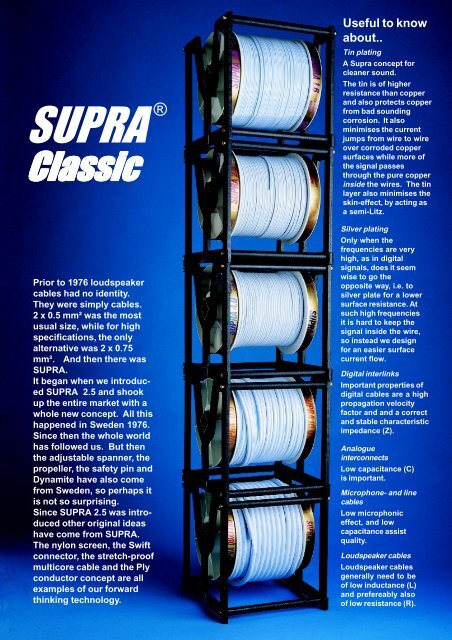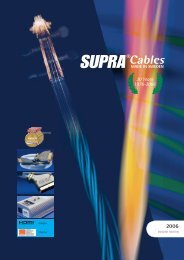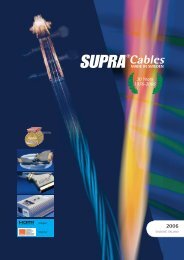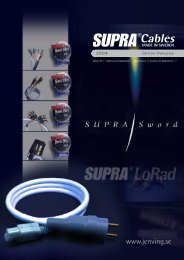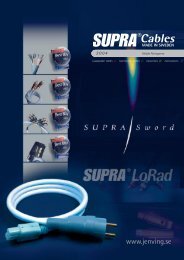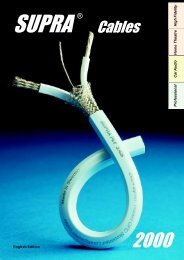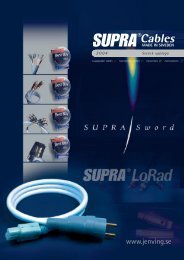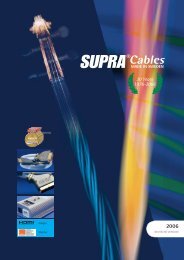English Edition High Fidelity Car A udio Professional ... - Supra cables
English Edition High Fidelity Car A udio Professional ... - Supra cables
English Edition High Fidelity Car A udio Professional ... - Supra cables
You also want an ePaper? Increase the reach of your titles
YUMPU automatically turns print PDFs into web optimized ePapers that Google loves.
SUPRA ®<br />
Classic<br />
Prior to 1976 loudspeaker<br />
<strong>cables</strong> had no identity.<br />
They were simply <strong>cables</strong>.<br />
2 x 0.5 mm² was the most<br />
usual size, while for high<br />
specifications, the only<br />
alternative was 2 x 0.75<br />
mm². And then there was<br />
SUPRA.<br />
It began when we introduced<br />
SUPRA 2.5 and shook<br />
up the entire market with a<br />
whole new concept. All this<br />
happened in Sweden 1976.<br />
Since then the whole world<br />
has followed us. But then<br />
the adjustable spanner, the<br />
propeller, the safety pin and<br />
Dynamite have also come<br />
from Sweden, so perhaps it<br />
is not so surprising.<br />
Since SUPRA 2.5 was introduced<br />
other original ideas<br />
have come from SUPRA.<br />
The nylon screen, the Swift<br />
connector, the stretch-proof<br />
multicore cable and the Ply<br />
conductor concept are all<br />
examples of our forward<br />
thinking technology.<br />
Useful to know<br />
about..<br />
Tin plating<br />
A <strong>Supra</strong> concept for<br />
cleaner sound.<br />
The tin is of higher<br />
resistance than copper<br />
and also protects copper<br />
from bad sounding<br />
corrosion. It also<br />
minimises the current<br />
jumps from wire to wire<br />
over corroded copper<br />
surfaces while more of<br />
the signal passes<br />
through the pure copper<br />
inside the wires. The tin<br />
layer also minimises the<br />
skin-effect, by acting as<br />
a semi-Litz.<br />
Silver plating<br />
Only when the<br />
frequencies are very<br />
high, as in digital<br />
signals, does it seem<br />
wise to go the<br />
opposite way, i.e. to<br />
silver plate for a lower<br />
surface resistance. At<br />
such high frequencies<br />
it is hard to keep the<br />
signal inside the wire,<br />
so instead we design<br />
for an easier surface<br />
current flow.<br />
Digital interlinks<br />
Important properties of<br />
digital <strong>cables</strong> are a high<br />
propagation velocity<br />
factor and and a correct<br />
and stable characteristic<br />
impedance (Z).<br />
Analogue<br />
interconnects<br />
Low capacitance (C)<br />
is important.<br />
Microphone- and line<br />
<strong>cables</strong><br />
Low microphonic<br />
effect, and low<br />
capacitance assist<br />
quality.<br />
Loudspeaker <strong>cables</strong><br />
Loudspeaker <strong>cables</strong><br />
generally need to be<br />
of low inductance (L)<br />
and prefereably also<br />
of low resistance (R).


